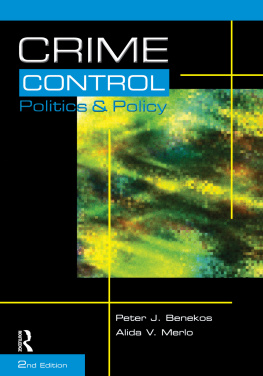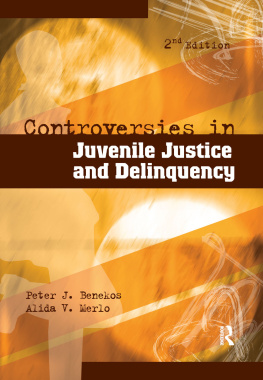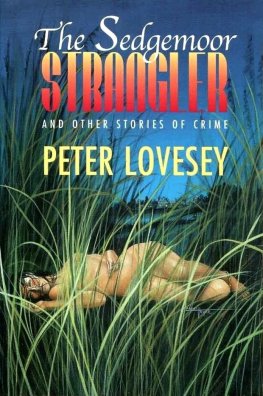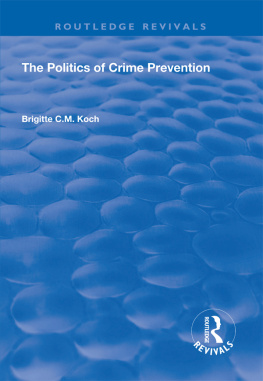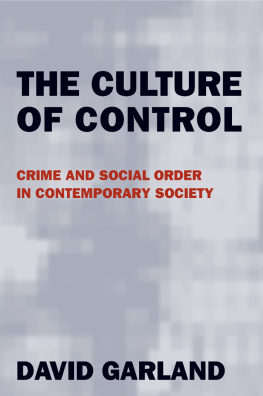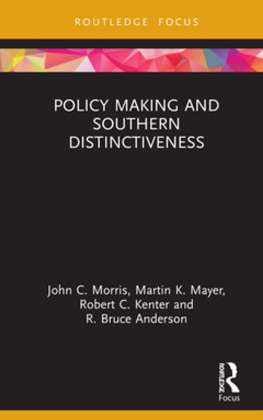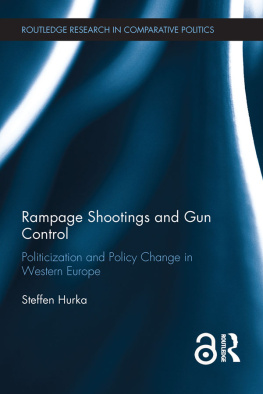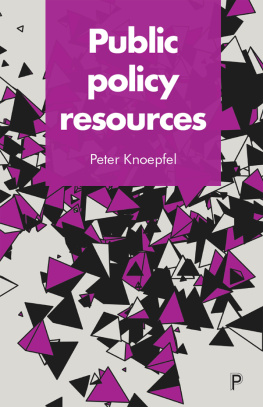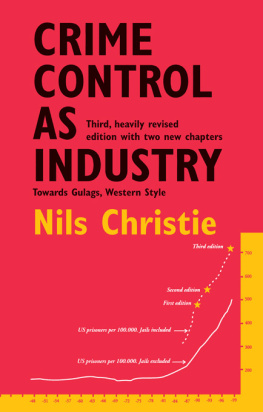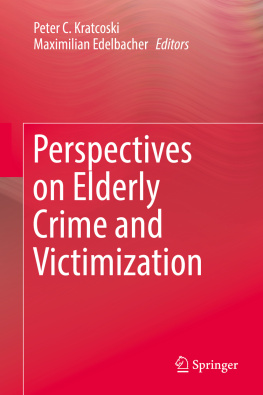Crime Control
Politics & Policy
2nd Edition
Peter J. Benekos
Mercyhurst College
Alida V. Merlo
Indiana University of Pennsylvania
Crime Control, Politics, and Policy, Second Edition
First published 2006 by Anderson Publishing
Published 2015 by Routledge
2 Park Square, Milton Park, Abingdon, Oxon OX14 4RN
and by Routledge
711 Third Avenue, New York, NY 10017, USA
Routledge is an imprint of the Taylor & Francis Group, an informa business
Copyright 2000, 2006
Taylor & Francis. All rights reserved.
No part of this book may be reprinted or reproduced or utilised in any form or by any electronic, mechanical, or other means, now known or hereafter invented, including photocopying and recording, or in any information storage or retrieval system, without permission in writing from the publishers.
Notices
No responsibility is assumed by the publisher for any in ury and/or damage to persons or property as a matter of products liability, negligence or otherwise, or from any use of operation of any methods, products, instructions or ideas contained in the material herein.
Practitioners and researchers must always rely on their own experience and knowledge in evaluating and using any information, methods, compounds, or experiments described herein. In using such information or methods they should be mindful of their own safety and the safety of others, including parties for whom they have a professional responsibility.
Product or corporate names may be trademarks or registered trademarks, and are used only for identification and explanation without intent to infringe.
Library of Congress Cataloging-in-Publication Data
Benekos, Peter J.
Crime control, politics, and policy / Peter J. Benekos, Alida V. Merlo -- 2nd ed.
p. cm.
Includes bibliographical references and index.
ISBN 978-1-59345-347-3 (pbk)
1. Criminal justice, Administration of--United States. 2. Law enforcement--United States. 3. Mass media and crime--United States. 4. Corrections--United States. 5. Juvenile justice, Administration of--United States I. Merlo, Alida V. II. Title.
HV9950.B46 2006
364.973--dc22
2005036773
ISBN-13: 978-1-59345-347-3 (pbk)
Cover design by Tin Box Studio, Inc./Cincinnati, Ohio
Cover photography by Olivia Grondin
EDITOR Ellen S. Boyne
ACQUISITIONS EDITOR Michael C. Braswell
To Pat
To Kevin and Alexandra
Special appreciation to my loving wife, Pat, for her continued understanding and patience. Her encouragement supports my work and makes my efforts more successful. Thanks also to my mother, Lil, for her love and joy.
PJB
A number of people have provided us with assistance and support throughout this project. We are delighted to have had the opportunity to work with our friends at LexisNexis/Anderson Publishing Co. We thank Mickey Braswell at LexisNexis/Anderson who first nurtured our ideas, helped us to refine them, and provided us with valuable feedback. Thanks to Frank Cullen for his review of the first manuscript. His comments were incisive and very helpful in guiding the project. Kelly Grondin provided us with the opportunity to initiate and finish this book, and we are grateful for her long-standing support. We are also very excited to again work with Ellen Boyne, who does an excellent job of making our manuscript a polished product. It was a great honor and privilege to work together, and we appreciate all that she did to facilitate this project. Thank you, Ellen.
A special thank you to my mother, Clara Merlo, for her wisdom and love, and for all that she has done throughout my life. She is truly the wind beneath my sails. A final and especially heartfelt thank you to my husband, Kevin Ashley, whose candor, intelligence, humor, love, and support are the mainstays of my life, and to our daughter, Alexandra Ashley, who makes every day a holiday.
AVM
One of the prevailing policy issues facing the nation is what to do about crime. For the last four decades, this has become a major social, political, and economic problem that has also generated the growth of the academic and research discipline of criminal justice. As students of this problem, you are certainly aware of the increasing amounts of information and research findings that are disseminated to legislators, administrators, and the publicand are studied by scholars of criminal justice.
As professors of this academic discipline, we are often asked by students why the system is not more effective and why crime cannot be better controlled. While students regularly study what the criminal justice system should be doing and how it should be doing it, questions about why these efforts are not working are often left to concluding observations or critical thinking exercises. Some exceptions are Samuel Walkers treatise, Sense and Nonsense About Crime and Drugs: A Policy Guide , Sixth Edition, and Jeffrey Reimans The Rich Get Richer and the Poor Get Prison , Sixth Edition. In this tradition, we attempt to focus the crime and justice debate by asking you, the reader, to consider criminal justice policies that deal with crime prevention and crime control.
Our intent is to review concepts, information, and points of view that help to explain the context and constraints of the criminal justice system. From an interdisciplinary perspective, we want to engage the reader in a critique of criminal justice as a means of moving the discussion to a more informed and insightful level and to create enthusiasm and understanding about what can be done by the criminal justice system.
To accomplish this goal, we encourage you to adopt what Mills called the sociological imagination (1959). This requires you to read, take notes, reflect, discuss, and critique the following chapters in order to examine the implications of the information. In other words, we want to engage you in a dialogue to consider what can be done to improve the system of criminal justice. Our effort is not intended to review all the literature or present a compendium of information, but rather to select the themes and evidence that we believe reflect important, useful, and timely information. We encourage you to question the ideas and to let us know what you think about criminal justice.
This critique of criminal justice is organized into seven chapters. We begin by summarizing what we have found to be salient themes and concepts that are helpful in understanding recent developments in public policy and crime control. Three themes that are central to the discussion are the impact of ideology, the role of the media, and the politicization of crime and criminal justice. Because these perspectives will reappear throughout the book, it is worth the time to examine them carefully and to have a sense of how they can be applied to the crime and justice topics.
presents a review of law enforcement initiatives and reforms, and deconstructs the thin blue line metaphor of policing. We critique the war model of crime control and assess the impact of the various wars on crime and drugs. Issues such as the excessive use of force, community policing, and the professionalization of policing are discussed. We consider some successful strategies but also see a pattern of quick fix schemes.
A familiar theme in criminal justice is that sentencing drives the system. In examining the impact of sentencing reform on the system, summarizes some of the sentencing philosophies, goals, and models, and considers the politicization of the courts. Sentence enhancement statutes have been enacted in a number of states, and they have affected the size of the prison population. At the same time, there is evidence of a greater reluctance to sentence offenders to death. These changes signify a possible shift in our thinking about how best to deal with offenders.


